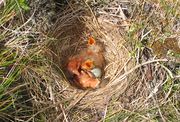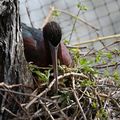Nest

A nest is a place of refuge to hold an animal's eggs and/or provide a place to live or raise offspring. They are usually made of some organic material such as twigs, grass, and leaves; or may simply be a depression in the ground, or a hole in a tree, rock or building. Human-made materials, such as string, plastic, cloth, hair or paper, may be used.
Generally each species has a distinctive style of nest. Nests can be found in many different habitats. They are built primarily by birds, but also by mammals (e.g. squirrels), fish, insects (e.g. wasps and termites) and reptiles (e.g. snakes and turtles).
The urge to prepare an area for the building of a nest is referred to as the nesting instinct and may occur in both mammals and birds.
Contents |
Bird nest

Most species of birds build some sort of nest, though some lay their eggs directly onto rock ledges or bare soil without first modifying the area.
Nest types vary from the very simple scrape, which is merely a shallow depression in soil or vegetation, to the elaborately woven pendant or sphere. Some birds will build nests in trees, some (such as vultures, eagles, and many seabirds like Kittiwakes) will build them on rocky ledges, and others nest on the ground or in burrows.
They may have some or all of the following zones: attachment; outer decorative layer; structural layer; lining.
Names of nests
- A badger's nest is called a sett.
- An eagle's nest is called an eyrie.
- A squirrel's or ringtail possum's nest is called a drey.
- A hare's nest is called a form.
- A pheasant's nest is called a nide.
- A wasp's nest is called a vespiary.
Gallery
 Nest in grass |
 The inside of a bird's nest |
 Redwings typically make ground nests |
 Mud nests made by swallows |
|
Female Bald Eagle on nest with egg |
 A nest in a lamp |
 A bird building a basket nest |
 Colonial pendant nests of Montezuma Oropendola |
 Wasp starting a nest |
 Insect nest in culvert, Wilcannia, New South Wales Australia |
Eastern gray squirrel's drey in South Nottinghamshire, England |
|
|
Oriental Turtle Dove, exposed after leaf fall, Chiba, Japan |
 A basket style nest |
 Common blackbird nest - Location: Donsbrüggen (Kleve) - Germany. |
 |
References
- Hansell, Bird nests and construction behaviour, CUP 2005, ISBN 0-521-01764-5
See also
- Oology
- Bird nest
- Bird's nest soup
- Crow's nest
- Nest box
